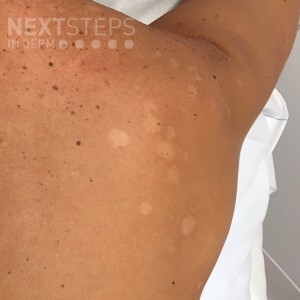
The correct answer is E. Kojic acid plays a role in decreased melanin synthesis.
Kojic acid is derived from fungi and inhibits tyrosinase. However, it does not play a role in decreased melanin synthesis. In the hypopigmented skin of tinea versicolor, there is a decreased density of melanosomes within keratinocytes, but no change in the melanocyte density. Abnormal melanosome production decreased melanin synthesis, and a partial block in melanosome transfer to keratinocytes have all been suggested as underlying defects. Azelaic acid, a competitive inhibitor of tyrosinase produced by Malassezia furfur, plays a role in the decreased melanin synthesis. Although the differential diagnosis may include postinflammatory hypopigmentation (e.g. secondary to parapsoriasis), progressive macular hypomelanosis, and early vitiligo, the diagnosis of tinea versicolor is easily confirmed by examination of the associated scale in a potassium hydroxide preparation.
1 – Azelaic acid inhibits tyrosinase produced by Malassezia furfur: Azelaic acid is a competitive inhibitor of tyrosinase produced by Malassezia furfur and plays a role in decreased melanin synthesis.
2 – Abnormal melanosome production: Abnormal melanosome production, decreased melanin synthesis and a partial block in melanosome transfer to keratinocytes have all been suggested as underlying defects in tinea versicolor.
3 – Decreased melanin synthesis: Abnormal melanosome production, decreased melanin synthesis and a partial block in melanosome transfer to keratinocytes have all been suggested as underlying defects in tinea versicolor.
4 – Partial block in melanosome transfer to keratinocytes: Abnormal melanosome production, decreased melanin synthesis and a partial block in melanosome transfer to keratinocytes have all been suggested as underlying defects in tinea versicolor.
References:
Hudson A, Sturgeon A, Peiris A. Tinea Versicolor. JAMA. 2018 Oct 2;320(13):1396. PMID: 30285180
